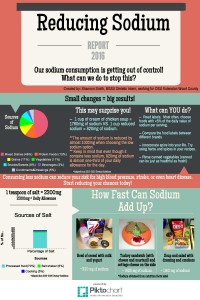According to the 2015-2020 Dietary Guidelines, 89% of the U.S. population ages 1 year and older have a sodium intake above the daily recommendation. Males (14-70 years old) average about 4320mg of sodium per day. On the other hand, females (14-70 years old) average about 3042mg of sodium per day . These numbers are alarming, as they vastly exceed the daily recommendation of 2300mg/day. But where does all of this sodium come from and what can we do to reduce these numbers? 44% of our sodium comes from mixed dishes, and it also can be found in protein foods, grains, vegetables, snacks and sweets, dairy, and condiments.
The fresh vegetables you buy from the grocery store do not contain much sodium. We begin to notice sodium when we choose canned vegetables. Canned vegetables are packed full of nutrients and can be an excellent choice for us. They are quick, easy, and affordable! However, this is where we find hidden sodium, unless we check the Nutrition Facts label. Look for products that say “reduced sodium,” “no salt added,” or “low sodium.” Rinsing the vegetables off can also remove excess sodium.
 Pay close attention to canned soups. 1 cup of cream of chicken soup has 1760mg of sodium. In contrast, 1 cup of reduced sodium cream of chicken has 820mg of sodium. The amount of sodium is reduced by almost 1000mg when choosing the low sodium option. Keep in mind that even though it contains less sodium, 820mg of sodium is almost one-third of your allowance for the day.
Pay close attention to canned soups. 1 cup of cream of chicken soup has 1760mg of sodium. In contrast, 1 cup of reduced sodium cream of chicken has 820mg of sodium. The amount of sodium is reduced by almost 1000mg when choosing the low sodium option. Keep in mind that even though it contains less sodium, 820mg of sodium is almost one-third of your allowance for the day.
Be cautious of words such as brined, smoked, pickled, cured, teriyaki, and barbecued and try to choose lower sodium options that say baked, poached, roasted, or steamed. Always check the Nutrition Facts label to see the amount of sodium found in a serving of that food. Sometimes choosing low sodium options can decrease the flavor of the food. However, that can be quickly fixed by simply adding an assortment of herbs and spices. Soups without added sodium can really be bland, but are so easy to spice up for extra flavor. Soup doesn’t have to be homemade in order to add those extra herbs and spices to enhance the flavor.
Sodium is found in a variety of foods that we wouldn’t even think of! 2 slices of whole wheat bread can have 210mg of sodium and one glass of skim milk contains about 130mg. Once the deli meat (~500mg sodium), cheese (2 slices ~300mg sodium), and mustard (~120mg sodium) is added to your bread, your meal contains about 1260mg of sodium. That is more than half the amount a person needs in one day! Sodium can add up very quickly. Eating too much sodium can really hinder our health. Too much sodium can result in high blood pressure, stroke, and heart attack . Therefore, keep a close eye on your sodium intake and pay close attention to the Nutrition Facts label.

